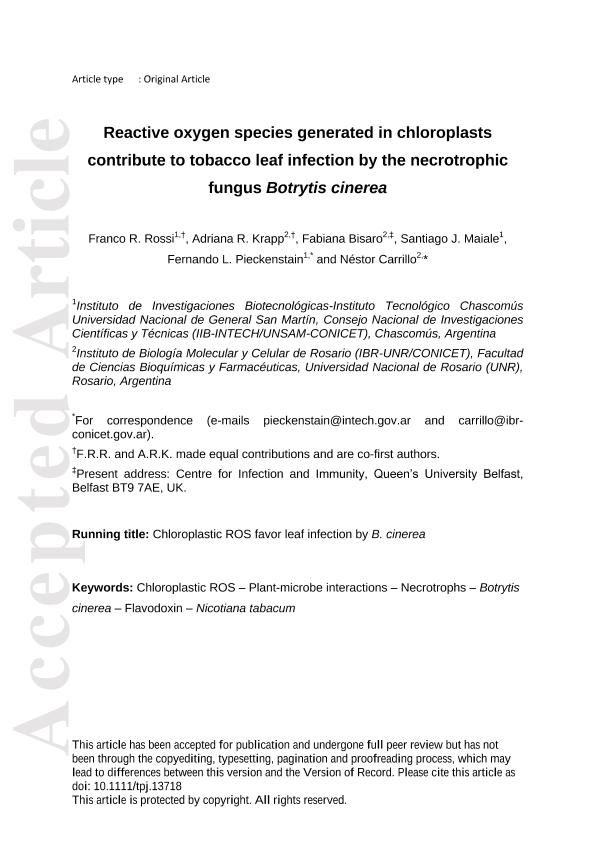Mostrar el registro sencillo del ítem
dc.contributor.author
Rossi, Franco Rubén

dc.contributor.author
Krapp, Adriana del Rosario

dc.contributor.author
Bisaro, Fabiana
dc.contributor.author
Maiale, Santiago Javier

dc.contributor.author
Pieckenstain, Fernando Luis

dc.contributor.author
Carrillo, Nestor Jose

dc.date.available
2018-06-26T21:08:33Z
dc.date.issued
2017-12
dc.identifier.citation
Rossi, Franco Rubén; Krapp, Adriana del Rosario; Bisaro, Fabiana; Maiale, Santiago Javier; Pieckenstain, Fernando Luis; et al.; Reactive oxygen species generated in chloroplasts contribute to tobacco leaf infection by the necrotrophic fungus Botrytis cinerea; Wiley Blackwell Publishing, Inc; Plant Journal; 92; 5; 12-2017; 761-773
dc.identifier.issn
0960-7412
dc.identifier.uri
http://hdl.handle.net/11336/50170
dc.description.abstract
Reactive oxygen species (ROS) play fundamental roles in plant responses to pathogen infection, including modulation of cell death processes and defense-related gene expression. Cell death triggered as part of the hypersensitive response enhances resistance to biotrophic pathogens, but favors the virulence of necrotrophs. Even though the involvement of ROS in the orchestration of defense responses is well established, the relative contribution of specific subcellular ROS sources to plant resistance against microorganisms with different pathogenesis strategies is not completely known. The aim of this work was to investigate the role of chloroplastic ROS in plant defense against a typical necrotrophic fungus, Botrytis cinerea. For this purpose, we used transgenic Nicotiana tabacum (tobacco) lines expressing a plastid-targeted cyanobacterial flavodoxin (pfld lines), which accumulate lower chloroplastic ROS in response to different stresses. Tissue damage and fungal growth were significantly reduced in infected leaves of pfld plants, as compared with infected wild-type (WT) counterparts. ROS build-up triggered by Botrytis infection and associated with chloroplasts was significantly decreased (70–80%) in pfld leaves relative to the wild type. Phytoalexin accumulation and expression of pathogenesis-related genes were induced to a lower degree in pfld plants than in WT siblings. The impact of fungal infection on photosynthetic activity was also lower in pfld leaves. The results indicate that chloroplast-generated ROS play a major role in lesion development during Botrytis infection. This work demonstrates that the modulation of chloroplastic ROS levels by the expression of a heterologous antioxidant protein can provide a significant degree of protection against a canonical necrotrophic fungus.
dc.format
application/pdf
dc.language.iso
eng
dc.publisher
Wiley Blackwell Publishing, Inc

dc.rights
info:eu-repo/semantics/openAccess
dc.rights.uri
https://creativecommons.org/licenses/by-nc-nd/2.5/ar/
dc.subject
Botrytis Cinerea
dc.subject
Chloroplastic Ros
dc.subject
Flavodoxin
dc.subject
Necrotrophs
dc.subject
Nicotiana Tabacum
dc.subject
Plant–Microbe Interactions
dc.subject.classification
Agricultura

dc.subject.classification
Agricultura, Silvicultura y Pesca

dc.subject.classification
CIENCIAS AGRÍCOLAS

dc.title
Reactive oxygen species generated in chloroplasts contribute to tobacco leaf infection by the necrotrophic fungus Botrytis cinerea
dc.type
info:eu-repo/semantics/article
dc.type
info:ar-repo/semantics/artículo
dc.type
info:eu-repo/semantics/publishedVersion
dc.date.updated
2018-06-22T15:51:59Z
dc.journal.volume
92
dc.journal.number
5
dc.journal.pagination
761-773
dc.journal.pais
Reino Unido

dc.journal.ciudad
Londres
dc.description.fil
Fil: Rossi, Franco Rubén. Consejo Nacional de Investigaciones Científicas y Técnicas. Centro Científico Tecnológico Conicet - La Plata. Instituto de Investigaciones Biotecnológicas. Instituto de Investigaciones Biotecnológicas ; Argentina
dc.description.fil
Fil: Krapp, Adriana del Rosario. Consejo Nacional de Investigaciones Científicas y Técnicas. Centro Científico Tecnológico Conicet - Rosario. Instituto de Biología Molecular y Celular de Rosario. Universidad Nacional de Rosario. Facultad de Ciencias Bioquímicas y Farmacéuticas. Instituto de Biología Molecular y Celular de Rosario; Argentina
dc.description.fil
Fil: Bisaro, Fabiana. Consejo Nacional de Investigaciones Científicas y Técnicas. Centro Científico Tecnológico Conicet - Rosario. Instituto de Biología Molecular y Celular de Rosario. Universidad Nacional de Rosario. Facultad de Ciencias Bioquímicas y Farmacéuticas. Instituto de Biología Molecular y Celular de Rosario; Argentina. The Queens University of Belfast; Irlanda
dc.description.fil
Fil: Maiale, Santiago Javier. Consejo Nacional de Investigaciones Científicas y Técnicas. Centro Científico Tecnológico Conicet - La Plata. Instituto de Investigaciones Biotecnológicas. Instituto de Investigaciones Biotecnológicas ; Argentina
dc.description.fil
Fil: Pieckenstain, Fernando Luis. Consejo Nacional de Investigaciones Científicas y Técnicas. Centro Científico Tecnológico Conicet - La Plata. Instituto de Investigaciones Biotecnológicas. Instituto de Investigaciones Biotecnológicas ; Argentina
dc.description.fil
Fil: Carrillo, Nestor Jose. Consejo Nacional de Investigaciones Científicas y Técnicas. Centro Científico Tecnológico Conicet - Rosario. Instituto de Biología Molecular y Celular de Rosario. Universidad Nacional de Rosario. Facultad de Ciencias Bioquímicas y Farmacéuticas. Instituto de Biología Molecular y Celular de Rosario; Argentina
dc.journal.title
Plant Journal

dc.relation.alternativeid
info:eu-repo/semantics/altIdentifier/doi/http://dx.doi.org/10.1111/tpj.13718
dc.relation.alternativeid
info:eu-repo/semantics/altIdentifier/url/https://onlinelibrary.wiley.com/doi/abs/10.1111/tpj.13718
Archivos asociados
